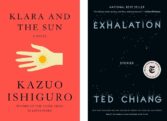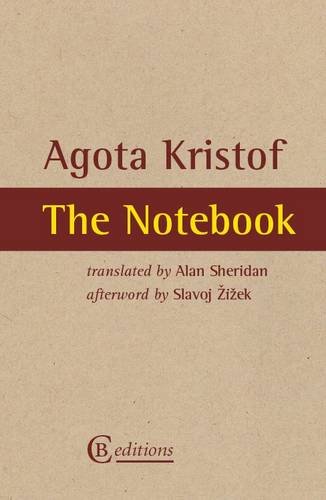
by by Margaret Kolb

Published by CB Editions, 2014 | 174 pages
The word asceticism comes from the word askesis, the ancient Greek word for the period of training and fasting that athletes underwent before competing in the Olympic games. If originally developed as a practical measure against physical hardships of competitive sport, it soon became synonymous with training undergone to prepare for more psychological forms of pain. The Cynic philosophers, for instance, voluntarily lived “like dogs” in the street to inure themselves to shame; later, certain monastic Christians sects would practice extreme self-denial and bodily mortification to articulate a theology that located the body as the site of death and sin. Agota Kristof’s 1986 novel The Notebook – first translated into English from the French by Alan Sheridan, now newly reissued by CB editions – fictionalizes its own extraordinary manifestation of asceticism, invoked perhaps as a study of the psychological afflictions Kristof may have experienced living as a child through the Second World War and subsequent Hungarian Revolution.
Born in 1935 in Hungary, Kristof lived through the Second World War only to be forced into exile with her husband and 4 month-old daughter in 1956 after the uprisings of the Hungarian Revolution were suppressed by the Soviet Army. After her swift departure from Hungary, Kristof settled in Switzerland where she took up work in a factory. As Kristof recounts in her autobiography, The Illiterate (also reissued by CB editions), when she finally began writing after years of silence, she wrote in French in a concerted effort to “conquer” her “enemy language.” Her first publications were poems and dramas, but her breakthrough came with the publication of The Notebook, the first in a trilogy of novels—The Notebook, The Proof, and The Third Lie—that trace the lives of two twin brothers. She lived in Switzerland for the rest of her life, and died on July 27th, 2011.
The Notebook has been modeled, to a degree at least, after classical folk tales like those of the Brothers Grimm—complex works of symbolism and allegory written before the emergence of the “children’s tale” removed all traces of severity from the genre. Folk tales are painted in broad strokes, relying upon universal referents that serve as templates upon which to allegorize the particular. So it is with The Notebook; its cast of characters includes Mother, Father, Witch, Little Town, Big Town. (Though the characters, locations, and nationalities in The Notebook remain unspecified, the settings described nevertheless are reminiscent of the wartime Hungary of Kristof’s own upbringing.)
As The Notebook begins, two twin brothers have been brought to the Little Town because of the bombings and raids that have been terrorizing the Big Town. They move in with their grandmother, who everyone calls the Witch because she is rumored to have poisoned her husband. The Witch lives in a dirty hovel in the middle of a small tract of farmland, and is comparatively self-sufficient, growing her own food and collecting rent from a foreign officer who lives in one of the rooms. Life does not necessarily improve here for the boys, as they are cruelly beaten and berated by their grandmother and the townspeople.
The narrative crux of The Notebook appears shortly after the twins are beaten, when they devise a regimen of extreme asceticism to inure themselves to the ugliness and cruelty of their new environment. They begin a series of “toughening exercises” that will accustom them to “heat, cold, hunger, whatever causes pain.” And “pain,” unsurprisingly, is understood to extend beyond physical pain, to anything that would make one “blush” or “tremble”:
The brothers define their guiding principle or ethical stance as that of “absolute need.” They beat each other, fast until they’re dizzy, lie immobile on the ground for hours on end, beg and steal and degrade themselves in public. Eventually, they graduate from these exercises by performing unspeakable acts of cruelty on animals and humans. “It’s precisely because we don’t like it. It’s for that reason that we must get used to it,” they explain. Their grandmother responds: “You’re right. It’s good to know how to kill when you have to.” principle of absolute need compels the twins to learn to kill, the same principle also leads them to help others at times. Encountering a deserter hiding in the woods, they care for him and bring him food and a blanket, denying that they have acted out of kindness. “We weren’t trying to be kind. We’ve brought you these things because you absolutely need them. That’s all.”We sit down at the kitchen table opposite one another and, looking each other in the eyes, we say more and more terrible words. One of us says:‘Shit! Arse-hole!’ The other says:‘Bugger! Sod!’We go on like this until the words no longer reach our brains, no longer reach even our ears.
The title of the novel—“The Big Notebook” (Le grand cahier) in French—references the compositional exercises the twins undertake to record everything they see, hear, and do. The brothers innovate a new procedural tactic in which they assign a topic such as “Arrival at Grandmother’s” or “Our Tasks”—the titles of the first and fourth chapters—and take turns editing the text, marking it either “Good” or “Not Good.” Edited texts marked “Good” are then copied out into the Big Notebook. For a sentence to be good enough to get copied into the Big Notebook, the statement must be empirically “true” and “objective,” without any words that “lack precision.”
We would write: ‘We eat a lot of walnuts’ and not: ‘We love walnuts’, because the word ‘love’ is not a definite word, it lacks precision and objectivity. ‘To love walnuts’ and ‘to love Mother’ don’t mean the same thing.Tempered by this narrative constraint, the language in which the notebook is written takes the form of disinterested, clinical observation, the radical empiricism of the exercise intended, perhaps, to allow the twins to overcome their natural emotional responses to the atrocities they must inevitably witness during war. “We look at Mother. her guts are coming out of her belly. She is red all over. So is the baby. Mother’s head is hanging in the hole made by the shell.” Evidence of their distress is suppressed, coming through only in their actions and snippets of recorded dialogue. After they witness a procession of death camp prisoners:
In one of The Notebook’s final scenes, soldiers have just ransacked their neighbor’s home. The twins go over to investigate, and find that the soldiers have raped and killed Harelip, a mentally disabled girl. Continuing into the house, the twins discover that Harelip’s mother, who was known to be blind and deaf, had in fact been faking her deafness and blindness, and had witnessed everything. Distraught at the tragedy, she begs the twins to kill her out of mercy. “We slit her throat with a razor, then we go and siphon off petrol from an army vehicle,” the twins record in the Big Notebook.‘It is unfortunate you have had to witness such a spectacle. You are trembling all over.’‘So are you, Father.’‘Yes. I am old, I am trembling.’
Kristof’s novel enacts, perhaps, enacts a fantasy of insensitivity and invulnerability that she herself had not been able to achieve during her youth and exile. She fled Hungary in 1956 without saying goodbye to her family. When she returned in 1968, she could no longer recognize her younger brother.
Anelise Chen is a writer and teacher currently living in New York City. She is the Fiction Editor at the Asian American Writers’ Workshop. You can follow her @anelise_chen.















click to see who
MAKE Magazine Publisher MAKE Literary Productions Managing Editor Chamandeep Bains Assistant Managing Editor and Web Editor Kenneth Guay Fiction Editor Kamilah Foreman Nonfiction Editor Jessica Anne Poetry Editor Joel Craig Intercambio Poetry Editor Daniel Borzutzky Intercambio Prose Editor Brenda Lozano Latin American Art Portfolio Editor Alejandro Almanza Pereda Reviews Editor Mark Molloy Portfolio Art Editor Sarah Kramer Creative Director Joshua Hauth, Hauthwares Webmaster Johnathan Crawford Proofreader/Copy Editor Sarah Kramer Associate Fiction Editors LC Fiore, Jim Kourlas, Kerstin Schaars Contributing Editors Kyle Beachy, Steffi Drewes, Katie Geha, Kathleen Rooney Social Media Coordinator Jennifer De Poorter
MAKE Literary Productions, NFP Co-directors, Sarah Dodson and Joel Craig